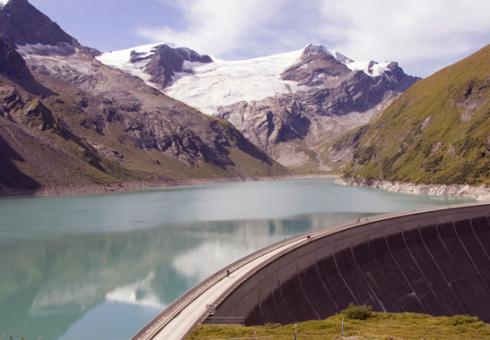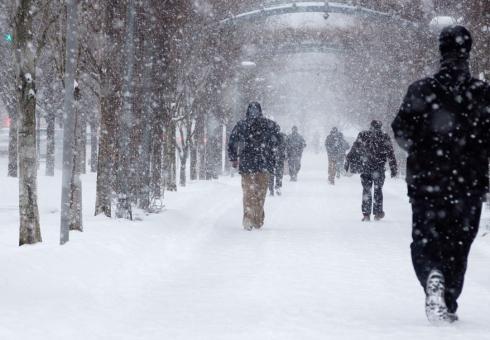News + Media
BusinessGreen -- Latest Energy and Climate Outlook predicts world on track for temperature increases of 3.3C to 5.6C this century, presenting huge challenge to global economy
by BusinessGreen staff
MIT has added its voice to the cacophony of scientific institutions presenting warnings on the true scale of projected climate impacts, with the publication of a new report arguing we are currently on track to far exceed the 2C temperature goal set by the international community.
The 2014 Energy and Climate Outlook, published earlier this week, predicts that based on current emission reduction commitments the world is likely to see temperature increases of 3.3C to 5.6C by the end of the century, well above the 2C mark that scientists have warned could trigger "dangerous" levels of irreversible climate change.
"Our world is rapidly changing," said John Reilly, co-director of the MIT Joint Program and a coauthor of the report, in a statement. "We need to understand the nature of the risks we're facing so we can prepare for them."
The report also modelled scenarios where world leaders agree a deal at next year's Paris Summit to curb emissions, but it warned that even with ambitious new commitments to curb emissions post 2020 the world was still likely to release enough greenhouse gases into the atmosphere by 2040 to make it unlikely that the 2C goal will be met.
"There is some uncertainty associated with these estimates," said Erwan Monier, a research scientist at the Joint Program and a coauthor of the report, in a statement. "The fact is that there is uncertainty about future emissions, and also in the climate's response to those emissions. Yet, it is clear that we are not meeting the 2C target based on current efforts alone."
In addition, the report recognises that clean technologies will make "some headway", but it predicts the global energy system will continue to be dominated by fossil fuels in the coming decades as global energy use doubles by 2050.
"Population and economic growth are key drivers of change," said Reilly. "Developing countries like China and India are growing fast, and will play a big role in future emissions. They're also facing the unique challenge of trying to plan for this growth under a changing climate."
The report highlights the scale of the climate adaptation challenge faced by political and business leaders, and warns that disruption to water supplies could present a particularly acute risk to future economic development.
It predicts that rising temperatures will lead to a net increase in freshwater supplies of around 15 per cent this century as the hydrological cycle accelerates. But it also expects global water demand to increase 19 per cent, leading to increased water stress.
In addition, it predicts that higher temperatures could lead to significant changes in the distribution of precipitation and the timing of rainy seasons, posing a threat to growing seasons.
"These pressures on water will mean increased focus on making sure there is enough water where and when it is needed," said Charles Fant, a postdoctoral associate at the Joint Program and a coauthor of the report. "This can be done by transporting water to where it is needed, building more storage, or conservation and efficiency efforts."
The report came as the UK's Met Office this week confirmed that it expects this September to by the driest since records began in 1910, with exceptionally low rainfall for many parts of the country. It is also likely to finish in the top five warmest Septembers on record, with UK mean temperatures significantly above the monthly average.
John Reilly at Polytechnique Montréal. Can renewables become the dominant source of electricity in Canada and the USA?
An article published this week on the University of Nottingham Climate Policy Institute Blog: "China: Local incentives drive action on global climate change".
You can find the full article by following the link below:
http://blogs.nottingham.ac.uk/chinapolicyinstitute/2014/09/18/china-loc…;
Written by Da Zhang, Valerie J. Karplus and Zhang Xiliang.
As countries ponder post-2020 action to halt global climate change, China has emerged as a more determined and prepared contributor. Why? The need to address climate change is closely linked to urgent domestic priorities such as cleaning up the air and steering the economy toward a path of sustainable growth. Environmental action is no longer a luxury but an imperative for China’s citizens and policymakers, who recently declared war on the haze and smog they frequently wake up to. And because the severe air pollution problem and climate change share some common roots—burning coal and other fossil fuels—carefully planned countermeasures will address both. Recent policies enacted to address air quality combined with anticipated market-based approaches for enforcing future caps on emissions and pollution will deliver cuts in GHG emissions that could enable China to take a more ambitious position in post-2020 climate talks.
China’s leaders already take their international commitments on climate change very seriously. The country is on track to meet its Copenhagen commitment to reduce the carbon intensity (CO2 emission divided by GDP) by 40–45% in 2020, relative to 2005 levels. The carbon intensity reduction over the Eleventh Five-Year Plan (2005–2010) was 21%, and the 17% reduction targeted during the Twelfth Five-Year Plan (2011–2015) is considered achievable. A 16% reduction for the Thirteenth Five-Year Plan (2016–2020) will guarantee that China hits the higher end of its original commitment. However, post-2020 there are still huge uncertainties related to China’s future growth, technological improvement, and most importantly, policy stringency that will influence the shape of China’s emissions trajectory.
In recent research, we take a closer look at the impact of existing and proposed policy measures on China’s future emissions trajectory. These measures include carbon pricing through an emissions trading system, a fossil fuel resource tax, a feed-in-tariff (FIT) for renewable electricity, hydro and nuclear capacity expansion according to government plans, and additional policies included in the National Air Pollution Action Plan (e.g. reducing the share of coal in primary energy below 65% by 2017 by implementing higher resource taxes or caps on coal use). We design two scenarios — Continued Effort (CE) and Accelerated Effort (AE) representing the existing policies and more aggressive efforts respectively and simulate them using an energy-economic modeling tool we developed to study the impacts of energy and climate policy in China. We find that China’s emissions will peak around 2040 with current effort (CE scenario) and around 2030 with strong action (AE scenario). Coal use peaks earlier than CO2 around 2020 and declines very gradually through 2050 in both policy scenarios. Of all the policies included in the package, the carbon price does the heavy lifting—and because coal is the main fuel displaced the carbon price has huge co-benefits in terms of air quality improvement. The economic impact of these policies constitutes less than 1% of total consumption in 2030, which is both very modest and in line with broader efforts to transition to slower, more sustainable economic growth. Our results suggest that introducing a national cap and price on emissions starting with the Thirteenth Five-Year Plan (2016–2020) offers an opportunity for China to transition to a cleaner growth path in line with domestic and global environmental policy goals.
China is currently laying the foundation for such an approach known as an emissions trading system (ETS). The government is considering an ETS in order to minimize the costs of reducing carbon emissions while treating of equity issues through the initial allocation of emissions allowances. By mid-2014, all seven planned pilot-scale ETS programs had been launched in several provinces and cities, and five of them have already completed the compliance cycle for the first year, which has been viewed overall as smooth and successful. As the world second largest ETS after EU-ETS, these ETS pilots offer important lessons for the future expansion of the system to a full-fledged national scale. The ETS pilot designs are as varied as the seven areas they cover. Tailored to the circumstances of the pilot area, the designs include different demographics, priorities and industries. Chinese policy makers believe this process of experimentation will allow the local communities to tailor the ETS to meet their diverse needs as heterogeneity within Chinese provinces is even more significant than that among the member states involved in EU-ETS. A remaining question is how these diverse designs can be linked and coordinated under a national ETS.
Compared to the decade or so required for the development of the EU-ETS, Chinese plans to build a national ETS by 2020 that covers most polluting sectors are ambitious. Better coordination between central and provincial governments as well as among the multiple agencies that are involved in energy and climate policy making is needed to help identify interactions between policies and avoid redundancies. There is also a strong need to develop legislation that sets penalties for exceeding CO2 limits and enhances the transparency and independent reporting of carbon emissions. Capacity building at the local and national levels to train agencies to monitor, report and verify data will also benefit from more time to observe outcomes and incorporate lessons from existing ETS.
Looking ahead to the Paris conference next year, it is fair to expect a more determined and prepared China to take a more active role. However, we should not expect to see any miracles—China is still a developing country and any pledges to reduce emissions will be underpinned by—and not at odds with—its domestic agenda. The country still has a long way to go. Overseas support for technology transfer, knowledge sharing, and personnel training—especially as it relates to the construction and operation of an effective national ETS—will be crucial to build strong institutions that can support a low carbon transition within China’s economy without undermining economic growth. China’s readiness to consider emissions limits and market-based approaches to enforcing them should be both welcomed and supported by the global community.
Da Zhang is a postdoc in the MIT Joint Program on the Science and Policy of Global Change; Valerie J. Karplus is an Assistant Professor at the MIT Sloan School of Management; Zhang Xiliang is a Professor at the Institute of Energy, Environment and Economy in Tsinghua University.
MIT's Prof. Noelle Selin appeared on CBC's The Exchange with Amanda Lang to discuss the findings of a study recently published in Nature Climate Change. Watch the interview below.
What is the observational evidence that the ocean has warmed in recent years, and how difficult is it to quantify? Oceans at MIT asks Carl Wunsch about the limits of our knowledge.
Genevieve Wanucha
Oceans at MIT
Carl Wunsch (MIT PhD ’67), Cecil and Ida Green Professor Emeritus of Physical Oceanography at MIT, has spent an entire career investigating the ocean’s role in climate, from both observational and theoretical angles. Early in his career, he spent many months working at sea. He helped organize the World Ocean Circulation Experiment, which collected the most comprehensive data set from the global ocean, and chaired the science committees leading to the flight of altimetric satellites. He has provided analysis of the oceanic general circulation and its climate influences. Mathematical methods, such as inverse theory and state estimation, form his understanding of ocean circulation and climate.
Because the ocean has an enormous ability to absorb heat from the atmosphere, it’s only logical that the ocean has warmed, and will continue to warm, as increasing amounts of greenhouse gases trap heat in the atmosphere. But what is the observational evidence that the ocean has warmed in recent years and how difficult is it to quantify? Oceans at MIT asked Wunsch about the limits of our knowledge.
1. Is there evidence that the ocean has been warming?
Overall, the ocean does appear to have warmed over the last 20 years when, relatively speaking, there are enough data to do a reasonably accurate calculation. These recent observations come from Argo floats, altimetric satellite measurements, measurements made using elephant seals tagged with instruments that monitor ocean conditions, the World Ocean Circulation Experiment (WOCE) era and follow-up repeated high resolution shipboard data, and better meteorological estimates. Before 20 years ago, so few data exist that calculations remain highly uncertain.
It’s plausible that modern ocean temperature changes are proceeding faster than earlier in the Holocene Epoch (a relatively warm period in Earth’s history that began about 11,750 years ago at the close of the last major ice age), but that signal would be lost from the record if it had been present. Paleoceanographic data, which come from “proxies” such as planktonic shell measurements of oxygen isotope ratios, are very interesting sources of information about ocean temperatures thousands of years ago, but (A), they are so sparse that no one can compute an accurate global average, and (B) interpretation of these data means that the conversion to temperature makes the numerical values very uncertain. Furthermore, the time-spacing of those data that do exist make it almost impossible to detect rapid time changes in temperature. It’s a different problem altogether from the modern one.
2. You and MIT physical oceanographer Patrick Heimbach recently published a paper in the Journal of Physical Oceanography on the mathematical modeling of the temperature changes in the deep ocean. You found that parts of the ocean actually cooled in your model. What mechanism could be responsible for the cooling?
We estimated the change in heat content of the ocean over a 20-year period using all of the many different kinds of data that are available in the interval from 1992-2011. Overall, we estimated that the ocean warmed over the past 20 years. The year-to-year variations in any given region are very large, sometimes warming, sometimes cooling, making it hard to compute an accurate average top-to-bottom. Over the 20 years, parts of the ocean appear to have cooled somewhat—despite the fact that on average we found a net warming. No contradiction exists because the ocean can take a long time to respond to heating and cooling, and parts of it are likely just beginning to change owing to atmospheric conditions from hundreds of years ago.
An analogue is the way a large house responds to outside air temperatures: if the outside temperatures go up, some parts of the house will tend to heat up quickly, particularly if the sun shines directly through the windows. Other rooms may take hours or days to start to warm. If there is a deep basement, that might stay cool for weeks despite the rest of the house having warmed up, even when the attic is stifling. When the outside temperatures drop, parts of the house may still be warming up even as the more responsive rooms have started to cool down again. The ocean has many “rooms,” many far removed from where the sun is directly shining.
3. Do you believe that the observed warming is due to anthropogenic forcing from greenhouse gases?
That seems very likely—based upon some simple physical principles. If you add greenhouse gases to the atmosphere, it will warm up, and there is then a very powerful tendency for the ocean to warm as well, more slowly. Think of the house analogy again: if I turn on a heater in one room it’s difficult to see why the adjoining rooms would not slowly warm up, and then the rooms next to them, etc. If the heated room were perfectly insulated, that wouldn’t happen, but there’s no such thing as perfect insulation, and the ocean has no analogue of that anyway.
We know the atmosphere has warmed, although exactly how much and where is subject to some uncertainty, and so the most reasonable inference is that the ocean did too–although again, exactly where, and by how much, is a serious research question. If the atmosphere is in a state to warm the ocean, everyone would agree that the upper ocean will warm first. But, there are a lot of ifs and buts. If there were a natural warming of the atmosphere, maybe because cloud cover changed, the upper ocean would also warm first. So how does that tell you if the cause is natural or artificial? Also, the upper ocean exchanges water with the deeper ocean. One question we must consider is whether that exchange is leading to a warming or cooling of the upper ocean.
Study finds big snowstorms will still occur in the Northern Hemisphere following global warming.
The Atlantic reports on an MIT study that concludes that cost of limiting carbon emissions would pay for itself in human health benefits.
"
James Hamblin
The Atlantic
The polar ice caps feel remote. The threat of orioles permanently leaving Baltimore for cooler climates might be a little more compelling. But researchers are learning that the most effective way around climate-policy ambivalence is to invoke imminent dangers to human health. "What's killing me today?" with emphasis on killing and me and today.
For one, when there is more carbon dioxide in the environment, plants produce more pollen, which is no good for allergies and asthma. Rutgers allergist Leonard Bielory recently warned that pollen counts are projected to double by 2040. Likewise, U.S. foresters recently calculated that trees seem to be averting around $6.8 billion in human health costs annually, largely due to mitigating effects of air pollution (even if they do produce pollen). And already the World Health Organization is warning that air pollution is responsible for one out of every eight human deaths, largely because combustion of fossil fuels results in invisible airborne particles that get lodged in our lungs and suspended in our blood.
But is that worth the cost of implementing policies that limit carbon emissions? Some say yes.
Yesterday researchers released findings that say an economy-wide cap on carbon emissions stands to pay for itself about 10 times over in near-term human medical benefits, specifically reductions in costs associated with respiratory diseases, like asthma, and premature death. A standard, economy-wide cap and trade program, the MIT-based research team found, would result in a net benefit of $125 billion in human health costs. The work is published in the journal Nature Climate Change.
“We were looking at ozone and particulate matter, the two biggest air quality issues in the United States,” Tammy Thompson, a research scientist at Colorado State University with the Cooperative Institute for Research in the Environment, told me.
The Christian Science Monitor writes about an MIT climate change study released Sunday, indicating that the cost of slashing coal-fired carbon emissions would be offset by reduced spending on public health. The EPA-funded study examined climate change policies similar to those proposed by the Obama administration in June.
Jared Gilmour
Christian Science Monitor
President Obama’s controversial plan to phase out coal and slash carbon emissions is an expensive one. But a new study suggests it could be cheaper than the alternative: pollution, poor air quality, and accompanying health costs.
Cutting emissions might lower health spending so drastically that the US could end up saving ten times more than it would cost to implement carbon reductions, according to a Massachusetts Institute of Technology study published Sunday in the journal Nature Climate Change.
Environmentalists have long argued that curbing pollution is good for protecting local habitats and public health. Recently, though, the push for tighter environmental protections has sometimes shifted the focus from human health and conservation to climate change. The MIT study ties both environmental paradigms together, demonstrating how policies targeting carbon emissions can boost public health by reducing the more conventional pollutants emitted alongside greenhouse gases. Those conventional pollutants include particulate matter and carbon monoxide, which officials link to increased incidence and severity of illnesses like asthma, heart disease, and lung cancer.




